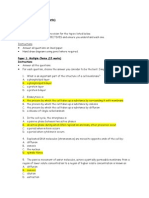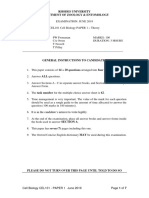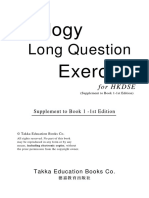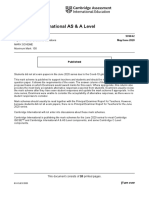Cell Bio 101 Theory June 2019
Uploaded by
mthombeninomfundo549Copyright:
Available Formats
Cell Bio 101 Theory June 2019
Uploaded by
mthombeninomfundo549Original Description:
Original Title
Copyright
Available Formats
Share this document
Did you find this document useful?
Is this content inappropriate?
Copyright:
Available Formats
Cell Bio 101 Theory June 2019
Uploaded by
mthombeninomfundo549Copyright:
Available Formats
lOMoARcPSD|38947585
CELL BIO 101 Theory June 2019
Cell biology (Cape Peninsula University of Technology)
Scan to open on Studocu
Studocu is not sponsored or endorsed by any college or university
Downloaded by Nomfundo Mthombeni (mthombeninomfundo549@gmail.com)
lOMoARcPSD|38947585
RHODES UNIVERSITY
DEPARTMENT OF ZOOLOGY & ENTOMOLOGY
EXAMINATION: JUNE 2019
CEL101 Cell Biology PAPER 1 – Theory
Internal Examiners: PW Froneman MARKS: 100
CA Owen DURATION: 3 HOURS
T Nowell
T Pillay
___________________________________________________________________
GENERAL INSTRUCTIONS TO CANDIDATES
1. This paper consists of 14 + 20 questions arranged into four (4) sections.
2. Answer ALL questions.
3. Answer Sections A - C in separate answer books, and Section D on the Multiple Choice
Answer Form.
4. The task number for the multiple choice answer sheet is 62.
5. Time management is very important. The value of the mark for each question
should be used as a rough guide to the amount of time allocated to answer the
question (100 marks in 180 minutes).
6. It is in the candidate’s interest to write legibly.
7. At the end of the examination, place all answer books and answer forms inside
the book used to answer SECTION A.
8. This paper has seven (7) pages including this one.
9. The Oxford Concise English dictionary MAY be used during this examination.
PLEASE DO NOT TURN OVER THIS PAGE UNTIL TOLD TO DO SO
Cell Biology CEL101 - PAPER 1 June 2019 Page 1 of 7
Downloaded by Nomfundo Mthombeni (mthombeninomfundo549@gmail.com)
lOMoARcPSD|38947585
SECTION A: Cell Structure (50 marks)
1. Draw a labelled diagram of a cross section through a cell membrane to show ten of
its structural features. 10 marks
2. Discuss the various factors that influence the permeability of cell membranes.
10 marks
3. Discuss why having organelles gives eukaryotic cells advantages over prokaryotic
cells. 5 marks
4. Answer all of the following questions that are related to the cytoskeleton. 5 marks
a. Which cytoskeletal filaments are found in a lattice just under the cell
membrane? 1 mark
b. Which cytoskeletal filaments anchor the nucleus of a cell? 1 mark
c. Which cytoskeletal filaments have the smallest diameter? 1 mark
d. From which of their ends do polar cytoskeletal filaments grow? 1 mark
e. What is the Microtubule Organizing Centre called in animal cells? 1 mark
5. Answer all of the following questions that relate to cell-to-cell attachment
a. What is a tight junction? 3 marks
b. What does ‘selective adhesion’ mean? 1 mark
c. What is the advantage of having selective adhesion between cells? 1 mark
6. Answer all of the following questions that are related to animal connective tissues.
a. What defines a tissue as a connective tissue? 2 marks
b. List the four different types of connective tissues and give an example of
each. 8 marks
7. Answer all of the following questions that relate to the sarcomeres in certain muscle
tissues.
a. Are relaxed sarcomeres elongated or shortened? 1 mark
b. What produces the dark band in a sarcomere? 1 mark
c. Which filaments are anchored on the Z-discs in a sarcomere? 1 mark
d. Which two proteins work together to produce movement in the sarcomere,
and thus in the muscle tissue? 2 marks
SECTION B: Photosynthesis and Respiration (15 marks)
8. List all of the products of the following steps of respiration.
a. Glycolysis 1.5 marks
b. Pyruvate processing 1.5 marks
c. Citric acid cycle 2 marks
Cell Biology CEL101 - PAPER 1 June 2019 Page 2 of 7
Downloaded by Nomfundo Mthombeni (mthombeninomfundo549@gmail.com)
lOMoARcPSD|38947585
Figure 1.
9. Study Figure 1 and answer the following questions.
a. Name the metabolic pathway illustrated in Figure 1 and in which organelle
this cycle occurs. 2 marks
b. Complete the labels a-l in your answer book. 6 marks
c. For every three turns of this cycle, one molecule of label h is produced. How
many turns of this cycle would be required for the production of one glucose
molecule? 2 marks
SECTION C: Replicating and Reproducing Cells (15 marks)
10. Draw and label a diagram of a plant cell undergoing cytokinesis. 3 marks
11. Describe the process(es) of cytokinesis that you have illustrated in your previous
answer. 3 marks
12. Explain how primary transcript (pre-mRNA in this case) differs from mature RNA.
Use simple diagrams to support your explanation. 4 marks
13. For research on the inheritance of traits, what makes certain species suitable
candidates for use as model organisms? 3 marks
14. Give the correct scientific names of two model organisms that you are familiar with.
2 marks
Cell Biology CEL101 - PAPER 1 June 2019 Page 3 of 7
Downloaded by Nomfundo Mthombeni (mthombeninomfundo549@gmail.com)
lOMoARcPSD|38947585
SECTION D: Multiple Choice Questions (20 marks)
(ANSWER ON SHEET PROVIDED)
1. Which of the following statements is a correct distinction between autotrophs and
heterotrophs?
a. Only heterotrophs require chemical compounds from the environment.
b. Cellular respiration is unique to heterotrophs.
c. Only heterotrophs have mitochondria.
d. Autotrophs, but not heterotrophs, can nourish themselves beginning with
CO2 and other nutrients that are inorganic.
e. Only heterotrophs require oxygen.
2. The O2 evolved in photosynthesis comes from:
a. carbon dioxide.
b. water.
c. glucose.
d. (CH2O).
e. (C3H3O3).
3. Which of the following is the very next event that occurs when a chlorophyll
molecule absorbs light?
a. The energy is released as heat.
b. Fluorescence occurs.
c. The electron is boosted to an excited state.
d. Resonance energy transfer occurs.
e. The electron is transferred to an electron transport chain
4. In the antenna complex, light energy is transferred from one pigment molecule to
another by:
a. pigment activation.
b. fluorescence.
c. resonance energy transfer.
d. reduction.
e. oxidation.
5. In Photosystem II, energized electrons are transferred from pheophytin directly to:
a. chlorophyll a.
b. NADP+.
c. the oxygen-evolving complex.
d. plastoquinone.
e. PQA.
6. What are the products of the light reactions that are subsequently used by the Calvin
cycle?
a. oxygen and carbon dioxide
b. carbon dioxide and RuBP
c. water and carbon
d. electrons and photons
e. ATP and NADPH
Cell Biology CEL101 - PAPER 1 June 2019 Page 4 of 7
Downloaded by Nomfundo Mthombeni (mthombeninomfundo549@gmail.com)
lOMoARcPSD|38947585
7. Photorespiration lowers the efficiency of photosynthesis by preventing the
formation of
a. carbon dioxide molecules.
b. 3-phosphoglycerate molecules
c. ATP molecules.
d. ribulose bisphosphate molecules.
e. RuBP carboxylase molecules.
8. In chemiosmotic phosphorylation, what is the most direct source of energy that is
used to convert ADP + Pi to ATP?
a. energy released as electrons flow through the electron transport system
b. energy released from substrate-level phosphorylation
c. energy released from ATP synthase pumping hydrogen ions against their
concentration gradient
d. energy released from movement of protons through ATP synthase
e. No external source of energy is required because the reaction is exergonic
9. All of the following are functions of the citric acid cycle except
a. production of ATP.
b. production of NADH.
c. production of FADH2.
d. release of carbon dioxide.
e. adding electrons and protons to oxygen, forming water.
10. In the absence of oxygen, yeast cells can obtain energy by fermentation, resulting
in the production of
a. ATP, CO2 and ethanol (ethyl alcohol).
b. ATP, CO2, and lactate.
c. ATP, NADH, and pyruvate.
d. ATP, pyruvate, and oxygen.
e. ATP, pyruvate, and acetyl CoA.
Cell Biology CEL101 - PAPER 1 June 2019 Page 5 of 7
Downloaded by Nomfundo Mthombeni (mthombeninomfundo549@gmail.com)
lOMoARcPSD|38947585
11. The fact that within a double-stranded DNA molecule, adenine forms two hydrogen
bonds with thymine, and cytosine forms three hydrogen bonds with guanine, is
known as
a. semi-conservative replication.
b. complementary base pairing.
c. the secondary structure of a DNA molecule.
d. a double helix.
e. stem-loop pairing.
12. What provides the energy for the polymerisation reactions in DNA synthesis?
a. ATP.
b. DNA polymerase.
c. Phosphodiester bonds.
d. breaking of the hydrogen bonds between complementary DNA strands.
e. the deoxyribonucleoside triphosphates.
13. What is the major difference between eukaryotic DNA replication and prokaryotic
DNA replication?
a. Prokaryotic replication does not require a primer.
b. Prokaryotic chromosomes have a single origin of replication, while
eukaryotic chromosomes have multiple origins of replication.
c. DNA polymerase III of eukaryotes has both endonuclease and exonuclease
activity, while that of prokaryotes has only exonuclease activity.
d. In eukaryotes both strands of DNA are copied, while in prokaryotes only
one strand of the DNA is copied.
e. DNA polymerase of prokaryotes can add nucleotides to both 3’ and 5’ ends
of DNA strands, while those of eukaryotes function only in the 5’ ⟶ 3’
direction.
14. The formation of ova, or female reproductive cells, occurs when diploid germ cells
undergo meiosis. In female meerkats (Suricata suricatta), diploid germ cells
contain 36 chromosomes. At the beginning of meiosis I, a female meerkat germ cell
contains
a. 18 homologous pairs of chromosomes comprising a total of 36 chromatids.
b. 18 homologous pairs of chromosomes comprising a total of 36 chromatids.
c. 36 homologous pairs of chromosomes comprising a total of 72 chromatids.
d. 72 homologous pairs of chromosomes comprising a total of 144 chromatids.
e. 36 homologous pairs of chromosomes comprising a total of 36 chromatids.
Cell Biology CEL101 - PAPER 1 June 2019 Page 6 of 7
Downloaded by Nomfundo Mthombeni (mthombeninomfundo549@gmail.com)
lOMoARcPSD|38947585
15. Some cells have several nuclei per cell. How might such multinucleated cells arise?
a. repeated cytokinesis with no mitosis
b. repeated mitosis accompanied by cytokinesis
c. repeated mitosis without cytokinesis
d. nuclear fusion
e. multiple S phases before a cell enters mitosis
16. Which of the following correctly describes how mitosis and meiosis are similar?
a. Both mitosis and meiosis produce diploid daughter cells.
b. Both mitosis and meiosis occur in somatic cells.
c. Sister chromatids segregate to opposite poles of the cell during both mitosis
and meiosis.
d. Both mitosis and meiosis produce genetically identical daughter cells.
e. Crossing over occurs between homologous chromatids during both mitosis
and meiosis.
17. In mussels, brown colouring (B) is dominant, and blue colouring (b) is recessive. A
homozygous brown mussel crosses with a blue mussel. What percentage of
offspring are expected to be blue?
a. 25%
b. 100%
c. 75%
d. 50%
e. 0%
18. The alleles found in haploid organisms cannot be dominant or recessive. Why?
a. Dominance and recessiveness describe which allele is expressed in the
phenotype when different alleles occur in the same individual.
b. Because only one allele is present, alleles in haploid organisms are always
dominant.
c. Alleles in haploid individuals are transmitted like mitochondrial or
chloroplast DNA.
d. Because gene expression does not occur in haploid organisms.
e. Most haploid individuals are bacteria, and bacterial genetics is completely
different from eukaryotic genetics.
19. Which direction does genetic information flow during gene expression?
a. DNA ⟶ Protein ⟶ RNA
b. RNA ⟶ Genes ⟶ Protein
c. Protein ⟶ RNA ⟶ DNA
d. RNA ⟶ Protein ⟶ DNA
e. DNA ⟶ RNA ⟶ Protein
20. The following RNA strand was produced: 5' AAA AUG AGU AAG 3'. Which of the
following DNA strands could have been the template for this RNA?
a. 3' TTT ATG TGC TTC 5'
b. 3' UUU TAC UCA UUC 5'
c. 3' CTT ACT CAT TTT 5'
d. 3' AAA ATG AGT AAG 5'
e. 3' TTT TAC TCA TTC 5'
END OF THE EXAMINATION PAPER
Cell Biology CEL101 - PAPER 1 June 2019 Page 7 of 7
Downloaded by Nomfundo Mthombeni (mthombeninomfundo549@gmail.com)
You might also like
- Test Bank For Biochemistry A Short Course 4th Edition John Tymoczko Jeremy M Berg Gregory J Gatto JR Lubert Stryer100% (46)Test Bank For Biochemistry A Short Course 4th Edition John Tymoczko Jeremy M Berg Gregory J Gatto JR Lubert Stryer11 pages
- Test Bank for Becker's World of the Cell, 10th Edition by Jeff Hardin, James P.No ratings yetTest Bank for Becker's World of the Cell, 10th Edition by Jeff Hardin, James P.40 pages
- Unit 2 Progress Check: MCQ: Ap Biology Scoring GuideNo ratings yetUnit 2 Progress Check: MCQ: Ap Biology Scoring Guide21 pages
- Class 11 Bio Paper (2) - 240205 - 195646No ratings yetClass 11 Bio Paper (2) - 240205 - 1956466 pages
- Ch. 5 The Fundamental Unit of Life: 1 Mark QuestionsNo ratings yetCh. 5 The Fundamental Unit of Life: 1 Mark Questions3 pages
- A) The Area Never Roaded Serves As A Control For The Experimental Variables of Recontoured and AbandonedNo ratings yetA) The Area Never Roaded Serves As A Control For The Experimental Variables of Recontoured and Abandoned3 pages
- Test Bank for Biochemistry: A Short Course, 4th Edition, John Tymoczko, Jeremy M. Berg, Gregory J. Gatto Jr., Lubert Stryer PDF Download Full Book with All Chapters100% (5)Test Bank for Biochemistry: A Short Course, 4th Edition, John Tymoczko, Jeremy M. Berg, Gregory J. Gatto Jr., Lubert Stryer PDF Download Full Book with All Chapters46 pages
- SG Unit2PracticeA 636fcbbb5921f0.636fcbbcb842d0.93766030No ratings yetSG Unit2PracticeA 636fcbbb5921f0.636fcbbcb842d0.9376603021 pages
- SG Unit2PracticeB 636fcbe5ca63f5.636fcbe7508146.81740145No ratings yetSG Unit2PracticeB 636fcbe5ca63f5.636fcbe7508146.8174014528 pages
- Immediate download Biological Science Canadian 2nd Edition Freeman Test Bank all chapters100% (3)Immediate download Biological Science Canadian 2nd Edition Freeman Test Bank all chapters47 pages
- Exam 2 Cells Membranes Energy Metabolism Biol101 f13100% (1)Exam 2 Cells Membranes Energy Metabolism Biol101 f138 pages
- Test Bank For Biochemistry A Short Course 4th Edition John Tymoczko Jeremy M Berg Gregory J Gatto JR Lubert Stryer 3100% (53)Test Bank For Biochemistry A Short Course 4th Edition John Tymoczko Jeremy M Berg Gregory J Gatto JR Lubert Stryer 311 pages
- Biological Science Canadian 2nd Edition Freeman Test Bank PDF Download Full Book with All Chapters100% (5)Biological Science Canadian 2nd Edition Freeman Test Bank PDF Download Full Book with All Chapters36 pages
- Molecular Cell Biology 7th Edition Lodish Test Bank download pdfNo ratings yetMolecular Cell Biology 7th Edition Lodish Test Bank download pdf42 pages
- Genetics 1st Sem 2010 ALT a 121- SamuelJnr. SJNo ratings yetGenetics 1st Sem 2010 ALT a 121- SamuelJnr. SJ61 pages
- CBSE Class 11 Biology Sample Paper Set 2No ratings yetCBSE Class 11 Biology Sample Paper Set 23 pages
- 2324 Level L (Gr10 UAE - GULF) Biology Course QuestionsNo ratings yet2324 Level L (Gr10 UAE - GULF) Biology Course Questions75 pages
- Cbse Sample Paper - 08 Class-XI Biology (Theory) Time: 3 Hrs MM: 70 General InstructionsNo ratings yetCbse Sample Paper - 08 Class-XI Biology (Theory) Time: 3 Hrs MM: 70 General Instructions12 pages
- Bixby Knolls Preparatory Academy - San Antonio, Quezon: Science and Technology 8No ratings yetBixby Knolls Preparatory Academy - San Antonio, Quezon: Science and Technology 83 pages
- Cambridge International AS & A Level: Biology 9700/42 May/June 2020No ratings yetCambridge International AS & A Level: Biology 9700/42 May/June 202020 pages
- DNA Primers For Amplification of Mitochondrial Cytochrome C Oxidase Subunit I From Diverse Metazoan InvertebratesNo ratings yetDNA Primers For Amplification of Mitochondrial Cytochrome C Oxidase Subunit I From Diverse Metazoan Invertebrates6 pages
- Shotgun Metagenomics, From Sampling To Analysis: ReviewNo ratings yetShotgun Metagenomics, From Sampling To Analysis: Review13 pages
- (Advances in Veterinary Science and Comparative Medicine 34) Richard A. McFeely (Eds.) - Domestic Animal Cytogenetics - Advances in Veterinary Science and Comparative Medicine (1990, Academic Press)No ratings yet(Advances in Veterinary Science and Comparative Medicine 34) Richard A. McFeely (Eds.) - Domestic Animal Cytogenetics - Advances in Veterinary Science and Comparative Medicine (1990, Academic Press)317 pages
- Lecture Recombination - Homologous Recombination (Final)No ratings yetLecture Recombination - Homologous Recombination (Final)27 pages
- Effective Conference Posters: Jean-Luc DoumontNo ratings yetEffective Conference Posters: Jean-Luc Doumont8 pages
- BI115 หลักชีววิทยา (Priciples of biology)No ratings yetBI115 หลักชีววิทยา (Priciples of biology)315 pages
- Revision On Exam Coverage - Term 2 11 Advance Biology (Inspire)No ratings yetRevision On Exam Coverage - Term 2 11 Advance Biology (Inspire)73 pages
- Test Bank For Biochemistry A Short Course 4th Edition John Tymoczko Jeremy M Berg Gregory J Gatto JR Lubert StryerTest Bank For Biochemistry A Short Course 4th Edition John Tymoczko Jeremy M Berg Gregory J Gatto JR Lubert Stryer
- Test Bank for Becker's World of the Cell, 10th Edition by Jeff Hardin, James P.Test Bank for Becker's World of the Cell, 10th Edition by Jeff Hardin, James P.
- Unit 2 Progress Check: MCQ: Ap Biology Scoring GuideUnit 2 Progress Check: MCQ: Ap Biology Scoring Guide
- Ch. 5 The Fundamental Unit of Life: 1 Mark QuestionsCh. 5 The Fundamental Unit of Life: 1 Mark Questions
- A) The Area Never Roaded Serves As A Control For The Experimental Variables of Recontoured and AbandonedA) The Area Never Roaded Serves As A Control For The Experimental Variables of Recontoured and Abandoned
- Test Bank for Biochemistry: A Short Course, 4th Edition, John Tymoczko, Jeremy M. Berg, Gregory J. Gatto Jr., Lubert Stryer PDF Download Full Book with All ChaptersTest Bank for Biochemistry: A Short Course, 4th Edition, John Tymoczko, Jeremy M. Berg, Gregory J. Gatto Jr., Lubert Stryer PDF Download Full Book with All Chapters
- SG Unit2PracticeA 636fcbbb5921f0.636fcbbcb842d0.93766030SG Unit2PracticeA 636fcbbb5921f0.636fcbbcb842d0.93766030
- SG Unit2PracticeB 636fcbe5ca63f5.636fcbe7508146.81740145SG Unit2PracticeB 636fcbe5ca63f5.636fcbe7508146.81740145
- Immediate download Biological Science Canadian 2nd Edition Freeman Test Bank all chaptersImmediate download Biological Science Canadian 2nd Edition Freeman Test Bank all chapters
- Exam 2 Cells Membranes Energy Metabolism Biol101 f13Exam 2 Cells Membranes Energy Metabolism Biol101 f13
- Test Bank For Biochemistry A Short Course 4th Edition John Tymoczko Jeremy M Berg Gregory J Gatto JR Lubert Stryer 3Test Bank For Biochemistry A Short Course 4th Edition John Tymoczko Jeremy M Berg Gregory J Gatto JR Lubert Stryer 3
- Biological Science Canadian 2nd Edition Freeman Test Bank PDF Download Full Book with All ChaptersBiological Science Canadian 2nd Edition Freeman Test Bank PDF Download Full Book with All Chapters
- Molecular Cell Biology 7th Edition Lodish Test Bank download pdfMolecular Cell Biology 7th Edition Lodish Test Bank download pdf
- 2324 Level L (Gr10 UAE - GULF) Biology Course Questions2324 Level L (Gr10 UAE - GULF) Biology Course Questions
- Cbse Sample Paper - 08 Class-XI Biology (Theory) Time: 3 Hrs MM: 70 General InstructionsCbse Sample Paper - 08 Class-XI Biology (Theory) Time: 3 Hrs MM: 70 General Instructions
- Bixby Knolls Preparatory Academy - San Antonio, Quezon: Science and Technology 8Bixby Knolls Preparatory Academy - San Antonio, Quezon: Science and Technology 8
- Discovery-Based Learning in the Life SciencesFrom EverandDiscovery-Based Learning in the Life Sciences
- Success Topical Guidebook For GCE O Level Biology 1 5158From EverandSuccess Topical Guidebook For GCE O Level Biology 1 5158
- Cambridge International AS & A Level: Biology 9700/42 May/June 2020Cambridge International AS & A Level: Biology 9700/42 May/June 2020
- DNA Primers For Amplification of Mitochondrial Cytochrome C Oxidase Subunit I From Diverse Metazoan InvertebratesDNA Primers For Amplification of Mitochondrial Cytochrome C Oxidase Subunit I From Diverse Metazoan Invertebrates
- Shotgun Metagenomics, From Sampling To Analysis: ReviewShotgun Metagenomics, From Sampling To Analysis: Review
- (Advances in Veterinary Science and Comparative Medicine 34) Richard A. McFeely (Eds.) - Domestic Animal Cytogenetics - Advances in Veterinary Science and Comparative Medicine (1990, Academic Press)(Advances in Veterinary Science and Comparative Medicine 34) Richard A. McFeely (Eds.) - Domestic Animal Cytogenetics - Advances in Veterinary Science and Comparative Medicine (1990, Academic Press)
- Lecture Recombination - Homologous Recombination (Final)Lecture Recombination - Homologous Recombination (Final)
- Revision On Exam Coverage - Term 2 11 Advance Biology (Inspire)Revision On Exam Coverage - Term 2 11 Advance Biology (Inspire)

























































































